

Canadian Healthcare Network. Fruit and vegetable consumption and mortality from all causes, cardiovascular disease, and cancer: systematic review and dose-response meta-analysis of prospective cohort studies. Abstract Objective To examine and quantify the potential dose-response relation between fruit and vegetable consumption and risk of all cause, cardiovascular, and cancer mortality.
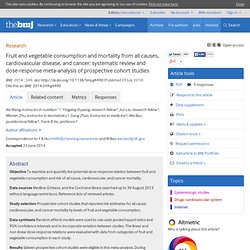
Data sources Medline, Embase, and the Cochrane library searched up to 30 August 2013 without language restrictions. Reference lists of retrieved articles. Study selection Prospective cohort studies that reported risk estimates for all cause, cardiovascular, and cancer mortality by levels of fruit and vegetable consumption. Data synthesis Random effects models were used to calculate pooled hazard ratios and 95% confidence intervals and to incorporate variation between studies.
Results Sixteen prospective cohort studies were eligible in this meta-analysis. Conclusions This meta-analysis provides further evidence that a higher consumption of fruit and vegetables is associated with a lower risk of all cause mortality, particularly cardiovascular mortality. Introduction Methods Search strategy Study selection Results.
E-Cigarettes Beat OTC Nicotine Replacement for Helping Smokers Quit. By Kelly Young Electronic cigarettes may be more effective than over-the-counter nicotine replacement therapies for smoking cessation, according to a cross-sectional study in Addiction.

Researchers surveyed nearly 6000 adults in the U.K. who tried to quit smoking at least once in the past year. Those who said they only used e-cigarettes to try to quit had a higher rate of self-reported abstinence (20%) than people who used OTC nicotine replacement therapies (10%) or no smoking cessation aids (15%). The differences remained after adjusting for the level of nicotine dependence. The authors note that "the evidence still favors the combination of behavioral support and prescription medication as providing the greatest chance of success. " Editor's note: While the embargo on this study has lifted, the study has not yet been published online. How Risky Are Psychiatric Medications? New Canadian guidelines for managing anxiety and related disorders. NIHB to accept pharmacist-initiated prescriptions as of June 15.
Warning: This closing technique could change your whole life. Effects of Blood Pressure on Development of S. Obstructive Sleep Apnea, Obesity, and Cardiovascular Risk Factors. A “Bionic Pancreas” for Type 1 Diabetics. Insulin Pump Lowers HbA1c Better Than Basal-Bolus Injections in Type 2 Diabete. Varenicline and Nicotine Replacement Together Are Better Than Varenicline Alone. Thrombolysis for PE: Weigh Risks and Benefits. In patients with intermediate-risk pulmonary embolism, thrombolytic therapy was associated with lower mortality but more bleeding.

Guidelines recommend that patients with massive pulmonary embolism (PE) and hemodynamic instability be treated with thrombolysis (Circulation 2011; 123:1788). However, consensus is lacking on what to do in intermediate-risk patients (i.e., those who are hemodynamically stable but have right ventricular dysfunction). Investigators performed a meta-analysis of 16 trials conducted during the last 45 years of thrombolysis for PE. Guide to Clinical Preventive Services, 2014. The Guide to Clinical Preventive Services includes U.S.
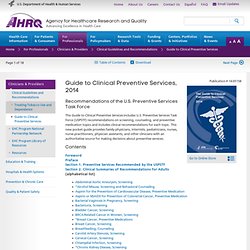
Preventive Services Task Force (USPSTF) recommendations on screening, counseling, and preventive medication topics and includes clinical recommendations for each topic. This new pocket guide provides family physicians, internists, pediatricians, nurses, nurse practitioners, physician assistants, and other clinicians with an authoritative source for making decisions about preventive services.
ForewordPrefaceSection 1. Preventive Services Recommended by the USPSTFSection 2. Clinical Summaries of Recommendations for Adults (alphabetical list) Section 3. Section 4. Appendixes Appendix A. *New recommendations released March 2012 to March 2014. The clinical summaries in this Guide are abridged versions of recommendations from the U.S. Recommendations made by the USPSTF are independent of the U.S.
Updated AAN Guidelines on Stroke Prevention in Nonvalvular Atrial Fibrillation. Warfarin in Patients with Atrial Fibrillation and Chronic Kidney Disease. Updated AAN Guidelines on Stroke Prevention in Nonvalvular Atrial Fibrillation. Resuming Anticoagulants Following ICH: Risky Business? Uninterrupted Rivaroxaban Appears Safe in Atrial Fibrillation Ablation. Prevention and Treatment of Venous Thromboembolism in Patients with IBD. Which Treatment for Parkinson-Related Cognitive Disorders? Steroids for COPD: Less Is Probably More.
The End of Levodopa Phobia? Quitting Smoking When the Nicotine Patch Is Not Enough. Quitting cigarette smoking is difficult, even with nicotine patches.
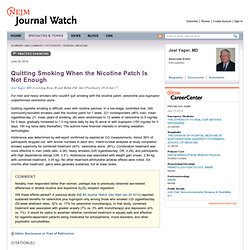
In a two-stage, controlled trial, 349 community-recruited smokers used the nicotine patch for 1 week; 221 nonresponders (46% men; mean cigarettes/day, 21; mean years of smoking, 26) were randomized to 12 weeks of varenicline (0.5 mg/day for 3 days; gradually increased to 1.0 mg twice daily by day 8) alone or with bupropion (150 mg/day for 3 days; 150 mg twice daily thereafter). The authors have financial interests in smoking cessation technologies. Abstinence was determined by self-report confirmed by expired-air CO measurements. About 36% of participants dropped out, with similar numbers in each arm. Varenicline and Nicotine Replacement Together Are Better Than Varenicline Alone. Direct-to-Patient Education Limits Benzodiazepine. Stress in Teenagers Affects Their Brains. Anxiolytics and Hypnotics Are Associated with Excess Mortality. Long-Term Augmentation of SSRIs with Atypical Antipsychotics: Is There a Need?
Warfarin May Not Reduce Stroke in Dialysis Patients with AF. Management of Atrial Fibrillation: 2014 Guidelines - NEJM J. Sponsoring Organizations: American College of Cardiology, American Heart Association, Heart Rhythm Society Target Population: Cardiologists, internal medicine practitioners, emergency medicine personnel Background and Objective This document is a thorough revision intended to replace the previous guidelines from the sponsoring organizations (published in 2006 and updated in 2011).

Key Points. Benefit of Renin-Angiotensin-Aldosterone Blockade in Patients with Diabetes Depends on the Drug. Might SSRIs Reduce the Risk for Alzheimer Disease? Printer. Eating 10 hot dogs in 6 minutes and belching the national anthem may impress your friends, but neither of those feats will do much for your body—at least not much good. Instead, why not train yourself to do something that may actually pay off? We're not talking bench presses and interval training (though those do help). You can teach your body to cure itself from everyday health ailments—side stitches, first-date jitters, even hands that have fallen asleep. Just study this list, and the next time your friends challenge you to an ice cream eating contest, chow down: You know how to thaw a brain freeze—and 17 other tricks that'll make everyone think you're the next David Blaine.
But without all that "hold your breath for 17 minutes" mess. Do Them Right: To mazimize your workout, good form is a must. Cure a Tickling Throat When you were 9, playing your armpit was a cool trick. Experience Supersonic Hearing If you're stuck chatting up a mumbler at a cocktail party, lean in with your right ear. Managing medications after bariatric surgery. Osteoarthritis: How pharmacists can play a key role in optimal management. Highlights of the 2014 Canadian hypertension guidelines. Unplanned readmissions after hospital discharge among patients identified as being at high risk for readmission using a validated predictive algorithm. Antiarrhythmic Therapy for Atrial Fibrillation. US Pharm. 2013;38(2):20-23.
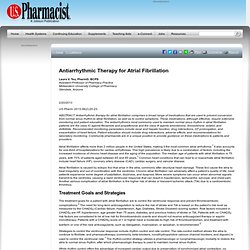
ABSTRACT: Antiarrhythmic therapy for atrial fibrillation comprises a broad range of medications that are used to prevent conversion from normal sinus rhythm to atrial fibrillation, as well as to control symptoms. These medications, although effective, require extensive monitoring and patient education. The antiarrhythmics most commonly used to maintain normal sinus rhythm in atrial fibrillation patients are the class IC agents flecainide and propafenone and the class III agents amiodarone, dronedarone, sotalol, and dofetilide. Recommended monitoring parameters include renal and hepatic function, drug interactions, QT prolongation, and exacerbation of heart failure. Patient education should include drug interactions, adverse effects, and recommendations for laboratory monitoring.
Atrial fibrillation is caused by ectopic foci that arise in the atria, commonly after structural heart damage. Documents. Bloody Easy 3: Blood Transfusions, Blood Alternatives and Transfusion Reactions.
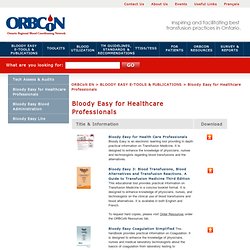
A Guide to Transfusion Medicine Third Edition This educational tool provides practical information on Transfusion Medicine in a concise booklet format. It is designed to enhance knowledge of physicians, nurses, and technologists on the clinical use of blood transfusions and blood alternatives. Lower-Intensity Statin Combo Therapy Bests High-Dose Monotherapy for LDL — But So What? By Amy Orciari Herman Combination therapy with a lower-dose statin plus either a bile acid sequestrant or ezetimibe reduces LDL cholesterol better than high-dose statin monotherapy, but long-term clinical benefits remain uncertain, according to a systematic review in the Annals of Internal Medicine.

Researchers examined data from 36 randomized, controlled trials of statin therapy among high-risk adults. A low-intensity statin, combined with a bile acid sequestrant, lowered LDL cholesterol 0%-14% more than moderate-intensity statin monotherapy. 2013 Heart Failure Guidelines. Frederick A.

Masoudi, MD, MSPH, FACC, FAHA Sponsoring Organizations: American College of Cardiology (ACC) Foundation, American Heart Association (AHA), American College of Chest Physicians, Heart Rhythm Society, International Society for Heart and Lung Transplantation. Www.rxfiles.ca/rxfiles/uploads/documents/Older-Adults. Smoking Cessation Myths #3 and #4: Nicotine replacement therapy. Smoking Cessation Myth #2: Smokers are unaware of why they should quit. Canadian Healthcare Network - Pharmacists.